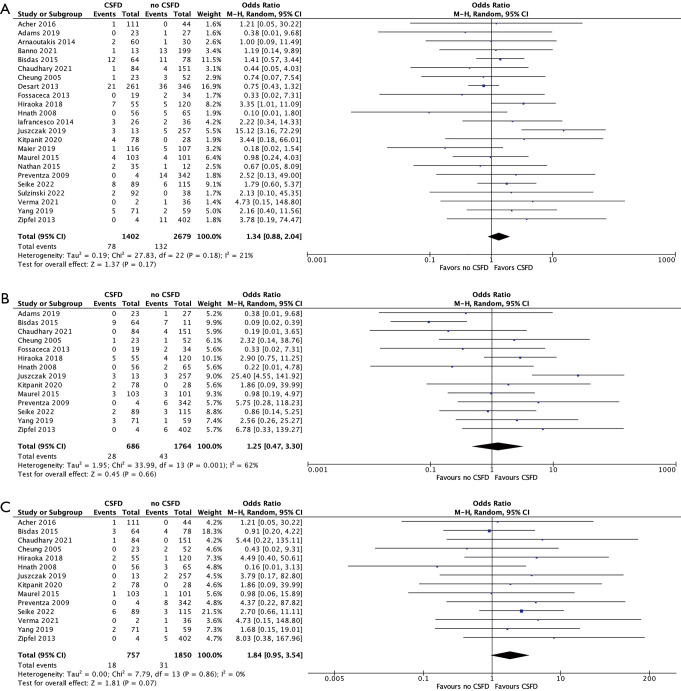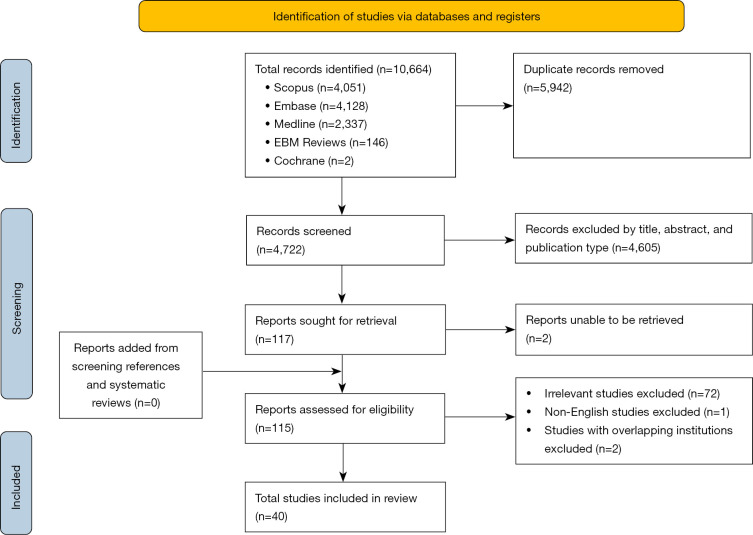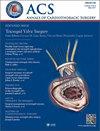胸腹血管内手术中预防性脑脊液引流和脊髓缺血:一项系统综述和荟萃分析。
IF 3.3
2区 医学
Q2 CARDIAC & CARDIOVASCULAR SYSTEMS
Annals of cardiothoracic surgery
Pub Date : 2023-09-28
Epub Date: 2023-07-12
DOI:10.21037/acs-2023-scp-17
引用次数: 0
摘要
背景:脊髓缺血(SCI)是胸主动脉腔内修复(TEVAR)最具破坏性的并发症之一。预防性脑脊液引流(CSFD)已被证明可以降低开胸主动脉手术中发生SCI的风险;然而,它在TEVAR中的效用仍然不确定。本系统综述和荟萃分析旨在确定预防性CSFD在TEVAR中预防SCI的作用。方法:对五个数据库进行文献检索,包括2022年9月之前发表的所有报告接受预防性CSFD的TEVAR患者SCI发生率的研究。对单臂数据的平均值或比例进行随机效应荟萃分析。报告了具有95%置信区间(CI)的比值比(OR),用于组间比较。结果:共纳入40项研究中的4793名接受TEVAR的患者。平均年龄68.8岁,男性占70.9%。总的SCI发生率为3.5%,其中即时SCI发生率1.3%,延迟性SCI发生率1.9%。预防性CSFD患者和非引流患者的SCI发生率没有显著差异。与未引流的患者相比,常规CSFD对SCI发生率没有显著影响。与非引流患者相比,选择性CSFD的短暂性SCI发生率增加(OR 2.08;95%CI:1.06-4.08;P=0.03)。最常见的引流相关并发症是脊髓性头痛(4.3%)。主要并发症发生率为1.6%,其中硬膜外或脊髓血肿(0.9%)最常见,其次是颅内或硬膜下出血(0.8%)和轻瘫或截瘫(0.8%)。结论:本研究发现,预防性CSFD患者与非引流患者的SCI发生率没有显著差异。CSFD与严重并发症的风险很小但不可忽略。多中心随机对照试验(RCT)有助于对接受血管内主动脉手术的患者中SCI和CSFD相关并发症的风险进行分层。本文章由计算机程序翻译,如有差异,请以英文原文为准。



Prophylactic cerebrospinal fluid drainage and spinal cord ischemia in thoracic and thoracoabdominal endovascular procedures: a systematic review and meta-analysis.
Background Spinal cord ischemia (SCI) is one of the most devastating complications of thoracic endovascular aortic repair (TEVAR). Prophylactic cerebrospinal fluid drainage (CSFD) has been shown to decrease the risk of SCI in open thoracic aortic procedures; however, its utility in TEVAR remains uncertain. This systematic review and meta-analysis aim to determine the role of prophylactic CSFD in preventing SCI in TEVAR. Methods A literature search of five databases was performed and all studies published before September 2022 that reported SCI rates in TEVAR patients undergoing prophylactic CSFD were included. A random effects meta-analysis of means or proportions was performed for single-arm data. Odds ratios (ORs) with 95% confidence intervals (CIs) were reported for comparisons between groups. Results A total of 4,793 patients undergoing TEVAR from 40 studies were included. The mean age was 68.8 years and 70.9% of patients were male. The overall SCI rate was 3.5%, with a 1.3% rate of immediate SCI and a 1.9% rate of delayed SCI. There were no significant differences in SCI rates between prophylactic CSFD patients and non-drained patients. Routine CSFD did not have a significant impact on SCI rates compared to non-drained patients. There was an increased rate of transient SCI with selective CSFD compared to non-drained patients (OR 2.08; 95% CI: 1.06–4.08; P=0.03). The most common drain-related complication was spinal headache (4.3%). The major complication rate was 1.6%, of which epidural or spinal hematoma (0.9%) was the most common, followed by intracranial or subdural hemorrhage (0.8%) and paraparesis or paraplegia (0.8%). Conclusions This study found no significant difference in SCI rates between prophylactic CSFD patients and their non-drained counterparts. CSFD is associated with a small but non-negligible risk of serious complications. Multi-center randomized controlled trials (RCTs) are warranted to help stratify the risk of both SCI and CSFD-related complications in patients undergoing endovascular aortic procedures.
求助全文
通过发布文献求助,成功后即可免费获取论文全文。
去求助
来源期刊

Annals of cardiothoracic surgery
Medicine-Surgery
CiteScore
4.60
自引率
0.00%
发文量
58
期刊介绍:
Information not localized
 求助内容:
求助内容: 应助结果提醒方式:
应助结果提醒方式:


